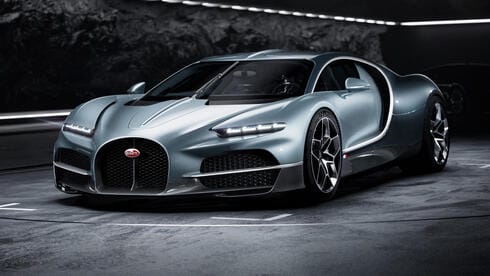Bugatti's $4 Million Tourbillon: A Monument to Excess in the Age of Climate Crisis
In a time when climate change and wealth inequality are pressing global issues, Bugatti's $4.1 million Tourbillon hypercar emerges as both a technological marvel and a glaring example of overconsumption.

In an era when the existential threat of climate change looms large and wealth inequality continues to widen, Bugatti has unveiled its latest feat of engineering excess—the $4.1 million Tourbillon hypercar.
Limited to just 250 units, this hybrid monster boasts a staggering 1,800 horsepower and a top speed of 248 mph. But as we marvel at its technological prowess, we must ask: Is this the pinnacle of automotive achievement or a tone-deaf ode to overconsumption?
The Tourbillon, named after a watchmaking innovation from 1801, is Bugatti's first venture into electrification. It's a hybrid that marries a naturally aspirated 8.3-litre V16 engine with three electric motors. On paper, it's an impressive technological achievement. In reality, it's a glaring example of how the ultra-wealthy continues to push the boundaries of conspicuous consumption, even as the world grapples with the consequences of our carbon-intensive lifestyles.
Let's break down the numbers:
- Price tag: $4.1 million. That's more than 80 times the median household income in the United States.
- Horsepower: 1,800. For context, the average car on the road has about 200 horsepower.
- Top speed: 248 mph. The fastest speed limit in the world (on Germany's Autobahn) is 80 mph.
- Production run: 250 units. Exclusivity at its finest – or most absurd.
Bugatti will undoubtedly tout the Tourbillon's hybrid powertrain as a step towards sustainability. The car can reportedly drive about 37 miles on electric power alone before the gas engine kicks in. But let's be real – this isn't about saving the planet. It's about preserving Bugatti's relevance in a world increasingly critical of gas-guzzling supercars.
The Tourbillon's electric capability is a fig leaf, a token gesture towards sustainability that does little to offset the environmental impact of manufacturing and operating such a vehicle. The carbon footprint of producing a single Tourbillon – from rare earth minerals for the electric components to the energy-intensive process of crafting its bespoke parts – is likely astronomical.
But perhaps the most egregious aspect of the Tourbillon is its interior. The centrepiece is an intricate mechanical gauge cluster crafted by Swiss watchmakers using over 600 parts, including gemstones and titanium. It's a horological masterpiece, to be sure, but it's also a perfect encapsulation of the wasteful excess that defines the hypercar market.
In a world where millions lack access to clean water and basic healthcare, where climate change threatens to displace millions more, the existence of a $4 million car with a gemstone-studded dashboard is nothing short of obscene.
Yet, we can't lay all the blame at Bugatti's feet. They're simply catering to a market that exists – a market of ultra-high-net-worth individuals who view such purchases as the ultimate status symbols. The real issue lies in the economic systems and societal values that have allowed such extreme wealth concentration in the first place.
The Tourbillon is a symptom of a larger problem – the growing disconnect between the ultra-wealthy and the rest of society. While most of the world grapples with inflation, climate anxiety, and economic uncertainty, a select few can casually drop millions on a car that will likely spend most of its time in a climate-controlled garage.
Moreover, the resources poured into developing and producing these hypercars represent a misallocation of engineering talent and manufacturing capacity. Imagine if the brilliant minds at Bugatti were instead focused on developing affordable electric vehicles for the masses or creating more efficient public transportation systems.
Some might argue that the Tourbillon pushes the boundaries of what's possible in automotive engineering and that these innovations will eventually trickle down to more accessible vehicles. However, this trickle-down theory of technology has proven to be as flawed in the automotive world as it is in economics.
The truth is that the kind of performance offered by the Tourbillon is utterly irrelevant to the needs of 99.99% of drivers. It's performance, for performance's sake, a dick-measuring contest among billionaires with too much money and too little regard for the world around them.
Let's not forget the safety implications. A car capable of reaching 248 mph has no place on public roads. It's a recipe for disaster, a threat to its driver and everyone in its vicinity. Pursuing ever-higher top speeds in road-legal cars is an exercise in irresponsibility.
Yet, despite all these criticisms, the Tourbillon will undoubtedly sell out. Its limited production run of 250 units ensures exclusivity, and for the ultra-wealthy, exclusivity is the ultimate luxury. Each sale will represent a triumph of engineering and a failure of our collective values.
As we stand on the brink of climate catastrophe, as wealth inequality reaches unprecedented levels, and economic and environmental pressures strain the very fabric of our societies, the Bugatti Tourbillon stands as a monument to our misplaced priorities.
It's a testament to human ingenuity, yes, but also to our capacity for self-indulgence and short-sightedness. It's a $4 million middle finger to sustainability, equality, and the idea that we're all in this together.
So, as Bugatti celebrates its latest creation, as the automotive press fawns over its specifications and design, let's take a moment to reflect on what the Tourbillon represents. It's not just a car. It's a symbol of a world out of balance, a world where the whims of the few outweigh the needs of the many.
The Bugatti Tourbillon is impressive, no doubt. But in the grand scheme, it's an impressive solution to a problem that doesn't exist, a triumph of engineering in service of vanity rather than progress.
In the end, the Tourbillon isn't just a hypercar. It's a hyper-clear illustration of everything wrong with our current economic system and collective priorities. Until we address these fundamental issues, there will be no amount.




